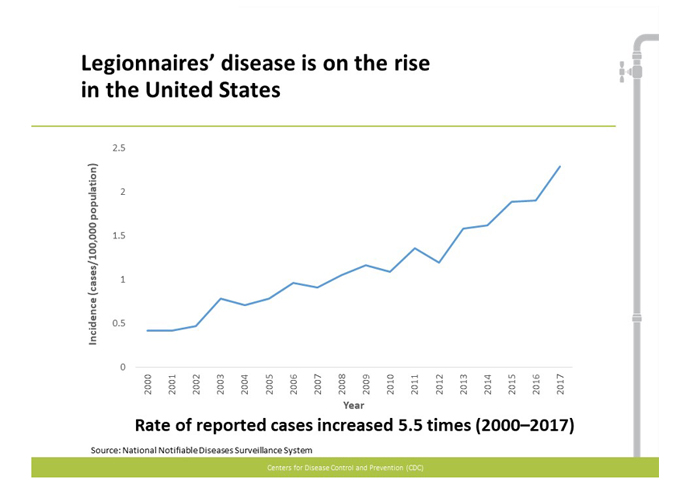|
|

|
  
Features
Update 2019/8/1
Legionnaires' disease
brought to you in part by

LEGIONNAIRES' DISEASE ON THE RISE -
THE CDC REMINDS RESIDENTS TO CHECK SHOWERHEADS, SINK FAUCETS, HOT TUBS, HOT WATER TANKS AND HEATERS
By Gillian Ward
As summer heats up across the country, Canadians depend on cooling towers in our office buildings to keep us comfortable at work. Water Today learned about one particularly ubiquitous pathogen, for which building managers need to maintain constant vigilance.
Legionella pneumophilia was identified by Center for Disease Control (CDC), Atlanta, USA after months of dedicated searching to determine the cause of death of scores of delegates at an American Legion convention during the summer of 1976. The association of so many of the victims of the outbreak alerted medical officials to consider an environmental source for the infection, later determined to be related to the hotel’s air cooling and circulation systems.
WaterToday consulted with Centers for Disease Control (CDC) in Atlanta to get details and trends on the incidence of Legionella cases.

The Legionella pneumophilia bacterium is found naturally in freshwater environments, posing no real health threat, but it can become a health concern when it proliferates inside of our building water systems.
CDC spokesperson Martha Sharan, Public Affairs Specialist informed us that there are many building fixtures that can harbour and grow the pathogen, including showerheads and sink faucets, hot tubs, hot water tanks and heaters, large plumbing systems and the cooling towers of larger buildings. (Note that most home and car air-conditioning units do not use water to cool the air, so they are not a risk for Legionella growth.)
While cases of Legionnaire’s Disease have increased to more than five times 2000 levels in the USA, the City of Ottawa Public Health says rates have held steady, with three cases being reported in the first half of 2019, and between 2 and 6 cases per year in this decade.
Lan Chi Nguyen Weekes, P.Eng is Director of Physical Resources, and sits as a Canadian expert on a US Panel studying Legionnaires’. She supplied Water Today with information on how Legionnaires is managed in Canada.
Canada’s National Building Code and National Plumbing Code each make specifications for buildings to minimize risk from the spread of aerosol pathogens, including Legionella. Once a new building is inspected and turned over for occupancy, there are no further inspections done on the operation of its systems unless a complaint is lodged. Public Works and Government Services Canada Publication MD 15161 – 2013 stands in for the ongoing operation of the building with Control of Legionella in Mechanical Systems, Standard for Building Owners, Design Professionals, and Maintenance Personnel, which was issued in March 2016.
Glen Strelau is Sr. Vice President of Pace Chemicals, a Canadian company supplying cleaning and maintenance products in western Canada. Strelau informed Water Today that Pace Chemicals refers clients to the 2016 Public Works guideline for Legionnaires and encourages all clients to do routine testing for the presence of the bacteria. Even so, these standards are not mandated or enforced. “It’s a matter of education for the building owners and managers”, Strelau says, whether the clients will undertake to follow the Public Works Canada guidelines. Pace supplied us with a copy of their in-house technical bulletin for Legionnaires, with background facts from CDC and recommendation for use of a periodic release biocide to eliminate pathogens from building cooling towers and air circulation systems.
Legionnaires’ shows up with pneumonia-like symptoms, including fatigue, chest pain and lung congestion. It is not normally spread through drinking water, though this is possible if by choking, water enters the lungs. For the most part, the illness is not transmitted from person to person.
There are milder versions of the illness, sometimes referred to as Pontiac fever, Legion fever or Philadelphia fever, but only the term “Legionnaires’ Disease” is used by CDC and the World Health Organization to refer to the most serious manifestation of the illness, which presents with pneumonia.
If you have concerns about your workplace HVAC system, inquire with building management about the maintenance program employed for Legionnaires and request test results. Seek medical attention early for pneumonia-like symptoms, as the illness can be treated with antibiotics.
gillian@watertoday.ca
|
|
|
Have a question? Give us a call 613-501-0175
All rights reserved 2025 - WATERTODAY - This material may not be reproduced in whole or in part and may not be distributed,
publicly performed, proxy cached or otherwise used, except with express permission.
|
| |